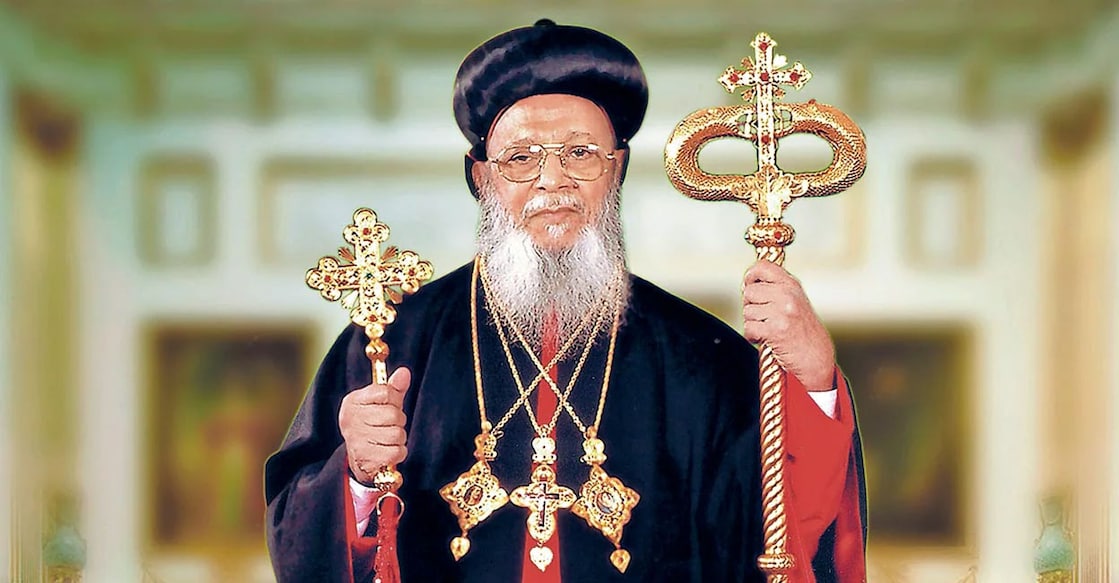Catholicos Baselios Thomas I: The mail runner who kept running for the Church

Mail This Article
"Dear blessed children," the words, repeated softly from the altar, have fallen silent with the passing of Catholicos Baselios Thomas I on Thursday.
The spiritual leader of the Jacobite Syrian Orthodox Church lived a life of struggle. Born the sixth of eight children of Cheruvillil Mathai and Kunjaamma of Vadayambadi in Ernakulam's Puthencruz, Thomas, also known as Kunjoonju's first fight was with epilepsy.
After failing to clear the Class 4 exams, little Kunjoonju tended the goats until he got a job as a mail runner (anjal pillai) at the post office. His job was to run to Trippunithura from Puthencruz with the mailbag and back. In between, he had to perform other tasks the postmaster assigned him.
When adult mail runners were paid Rs 90 per month, Kunjoonju, the boy, had to be satisfied with just Rs 16.
Father CM Thomas
Even as he kept running with the mailbag, evangelism was in little Thomas's mind. In 1952, he was ordained a Quroyo (or Korooyo) Reader.
"The diocese Metropolitan gave me a letter in 1958. He asked me to meet Elias Mar Yulious Bava at Manjanikkara. I didn't have money for a decent shirt, nor did I have a suitcase. I got a kameez (tunic) stitched with a cheap piece of cloth. A trunk box abandoned atop a chicken coop served as the suitcase. Armed with the trunk box and letter, I reached Omallur by bus and trekked a mountain to Manjanikkara," the late Bava once recalled his journey to priesthood.
He was ordained a priest at the Manjanikkara Dayara, a monastery of the Syrian Orthodox Church, on September 21, 1958. Fr Thomas was the 43rd priest from the Cheruvilli family.
Fr Thomas served as the vicar of churches in Puthencruz, Keezhmuri, Vellathooval, Malampuzha, Thrissur, Fort Kochi, and Kolkata. He even was the vicar of four churches simultaneously, and he had the opportunity to renovate many churches.
He preferred evangelism to parish administration. Fr Thomas became a regular in Church festivals and evangelist meetings across Malankara.
Thomas Mor Dionysius
Fissures in the Church widened in the 1970s. The Patriarch issued a decree accepting the activities of the Antioch Belief Protection Council. A meeting of the Angamaly diocese held at the Martha Mariyam Valiyapalli in Kothamangalam on December 8, 1973, recommended that the Patriarch consecrate Fr CM Thomas and Fr PM Varghese Parappallil as prelates.
Fr Thomas and Fr Parappallil's trip to Damascus was not smooth. Attempts were made to prevent their trip. They travelled at night and reached Bombay (now Mumbai). On February 24, 1974, both were consecrated as metropolitans.
On being consecrated, Fr Thomas became Thomas Mor Dionysius while Fr Parappallil became Geevarghese Mor Gregorios.
The Perumpalli diocese welcomed Geevarghese Mor Gregorius. The Angamaly diocese did not have a church as headquarters to accommodate Thomas Mor Dionysius. However, Valliyapalli welcomed him. Along with six priests, he took a taxi to Kothamangalam from Aluva Railway Station. He entered the cathedral at midnight and made the next 26 years a room beneath the staircase his residence. He later shifted to Mount Sinai Catholicate Aramana after its construction.
Thomas Mor Dionysius was in charge of the dioceses extending from Idukki to Palakkad. After taking over the charge of the Malabar Diocese, his jurisdiction extended up to Kasaragod. He was the head of the Angamaly diocese till his death.
Catholicos
Dr Geevarghese Mor Gregorios, the president of the Jacobite Church Episcopal Synod, passed away on February 22, 1999. After his death, the synod elected Thomas Mor Dionysius as its president. On December 27, the following year, he was selected as the Catholicos designate. He was consecrated as Catholicos with the title Baselios Thomas I. Though he stepped down as a Metropolitan trustee on April 27, 2019, he continued as the Catholicos.
The life of Baselios Thomas I was one of constant struggle, yet his address from the altar, "Dear blessed children," moistened the eyes of the laity, and they touched their hearts. He had slept on the street and in the Bishop's House. He transformed protest venues into spaces for prayer meetings. He suffered physical assault and went to jail for the Church. He undertook fasting for several days.
The Global Syrian Church recognised his contributions and considered him Yakub Burdhana (St. Jacob Baradaeus) of Malankara. Burdhana, a great saint, devoted all his energies to battle for the Church in the early sixth century. Similarly, Baselios Thomas I, who began as a mail runner, selflessly struggled for the Church.
Baselios Thomas I's eyes used to well up as he rendered the Syrian ekkara (a repertoire of hymns ) during the Holy Mass. He was once asked about the moist eyes and his shaky voice.
"My eyes well up when I stand face-to-face with Jesus Christ, thinking about our inadequacies and the mercies He showers upon us," he replied.
"God has consecrated me to shed tears for the people. My qualification is that I had failed twice in Class 4. Yet, he elevated me to the ranks of prelates. No one with little educational qualification like me has become a priest. I always remember it while standing on the altar," he added.
Baselios Thomas I took a path of struggles. He was a pillar of strength to thousands of believers. Their strength kept him going.
The Catholicos believed that resting while work was pending amounted to a sin. He did not fall into that sin. Once, newspapers published a picture of him carrying sand in a wicker basket on his head. He was then ferrying sand for the construction of a church.
The photograph, however, did not go down well with everyone. A complaint was made to the Metropolitan saying a priest should not be carrying sand on his head. The complaint resulted in an unexpected development. Later, priests were seen at the forefront of every church construction.

